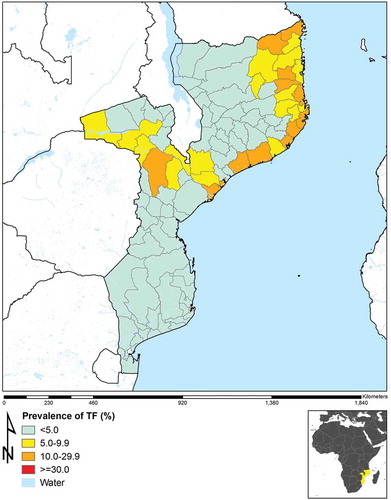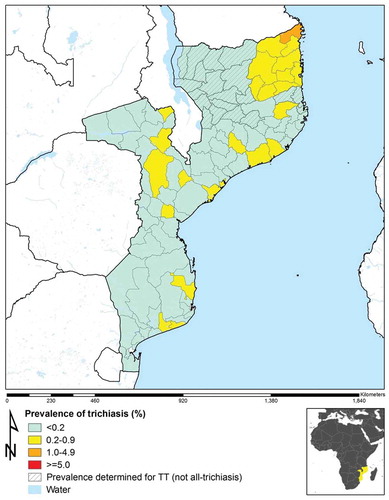Figures & data
Table 1. Prevalence of trachomatous inflammation—follicular (TF) in children aged 1–9 years and trichiasis in adults aged 15 years and above, by evaluation unit, Mozambique, 2012–2015. The name given to each evaluation unit is a concatenation of the names of its constituent districts.
Figure 1. Prevalence of trachomatous inflammation–follicular (TF) in those aged 1–9 years in 96 population-based prevalence surveys, Mozambique, 2012–2015.

Figure 2. Prevalence of trichiasis in those aged 15 years and above in 96 population-based prevalence surveys, Mozambique, 2012–2015. In 14 evaluation units (hatched), prevalence categories shown are for trachomatous trichiasis (TT), defined as trichiasis and (in the same eye) either (a) trachomatous conjunctival scarring (TS); or (b) the examiner’s inability to evert the eyelid to look for TS (with the difficulty in eversion presumed to be due to TS). In the other 82 evaluation units, prevalence categories shown are for all-trichiasis, regardless of the presence or absence of TS.

Table 2. Univariable mixed-effects logistic regression analysis of the outcome trachomatous inflammation–follicular (TF) in children aged 1–9 years against putative risk factors, using data from 91 population-based prevalence surveys, Global Trachoma Mapping Project, Mozambique, 2012–2015.
Table 3. Multivariable mixed-effects logistic regression analysis of the outcome trachomatous inflammation–follicular (TF) in children aged 1–9 years against putative risk factors, using data from 91 population-based prevalence surveys, Global Trachoma Mapping Project, Mozambique, 2012–2015.
